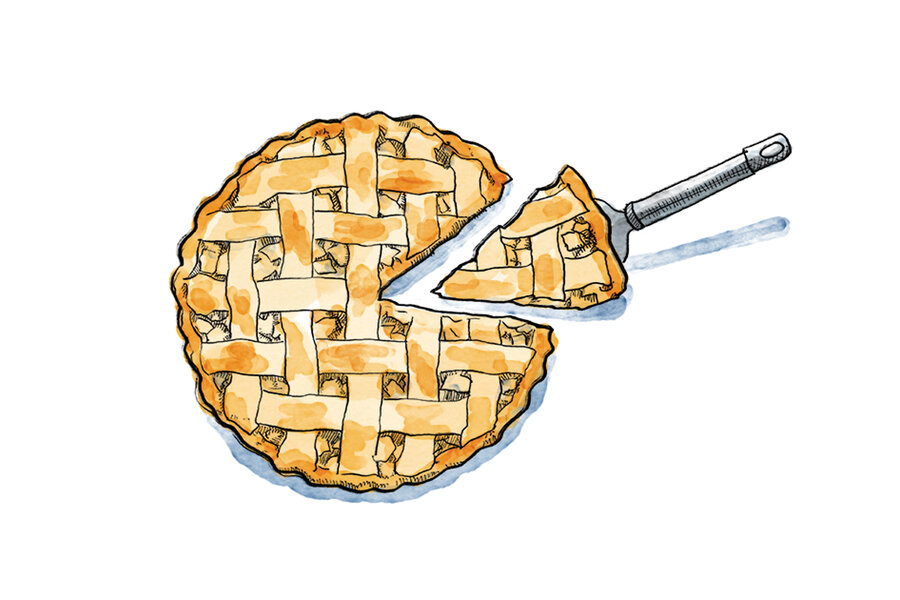Help in the kitchen or watch football? A Thanksgiving guest’s dilemma.
Loading...
No matter how progressive you or your family appear to be, traditional gender roles at Thanksgiving are as ubiquitous as paper pilgrim hats.
In the kitchen, (mostly) women bustle about in aprons. In another room, (mostly) men sit around the TV, counting the downs and the minutes until it is time to carve the turkey.
Why We Wrote This
Turkey Day is meant to be a feast that unites us. But gender stereotypes and turf battles can turn the table tense. Our writer has thoughts on how to skip the drama, not the dressing.
The kitchen can be a perilous obstacle course, and I don’t mean the too-crowded countertops and pots of boiling potatoes. It’s the culinary power play between self-appointed matriarchs and those trying to call audibles. “Stay out of the way” is the unspoken command. The closer as a family member you are to the matriarchal quarterback, the greater your potential for scoring a Thanksgiving touchdown.
“Homecoming” is one of the central myths of Thanksgiving. Sarah Josepha Hale, editor of the influential 19th-century magazine Godey’s Lady’s Book, campaigned tirelessly for almost two decades before the Civil War to establish Thanksgiving as a national holiday. Not only did she feel it was a rallying call to unify Americans around hearth and home, it presented an opportunity for the woman of the household to display her domestic talents. Even though I have resisted it, this siren call pulls me in at Thanksgiving, too.
On the surface, Thanksgiving promises to be the most unifying, satisfying experience in the American holiday calendar. Spend time with your family. Cook your favorite dishes. Watch football from the couch. Say grace. Eat as much as you want.
Simple, right?
Not exactly. In my experience, each one of those vignettes is carefully crafted to disguise the postmodern handwringing that is actually happening on the fourth Thursday of every November. No matter how progressive you or your family appears to be, the practice of traditional gender roles at Thanksgiving is as ubiquitous as paper pilgrim hats.
Why We Wrote This
Turkey Day is meant to be a feast that unites us. But gender stereotypes and turf battles can turn the table tense. Our writer has thoughts on how to skip the drama, not the dressing.
As a regular Thanksgiving guest, I am often filled with existential dread when I arrive at the doorstep. In one direction, the kitchen hums with activity amid the familiar smells of baking bread and pumpkin pie as (mostly) women bustle about in aprons. From the other comes the distant sounds of football on TV as (mostly) men sit counting the downs and the minutes until it is time to carve the turkey.
I’m not much of a football fan. But the kitchen can be a perilous obstacle course, and I don’t mean the too-crowded countertops and pots of boiling potatoes. It’s the culinary power play between self-appointed matriarchs and those trying to call audibles. (If you have ever been a willing or unwilling participant in kitchen turf battles, you get it.) “Stay out of the way” is the unspoken command. The closer as a family member you are to the matriarchal quarterback, the greater your potential for scoring a Thanksgiving touchdown.
This struggle manifests itself in various ways, from potluck dishes that don’t quite fit the menu to grumblings over cranberry sauce versus relish to the best way to make gravy. After all, if your favorite dish isn’t represented at the Thanksgiving table, does your family even know who you are? And what about the vegans and the vegetarians?
“Homecoming” is one of the central myths of Thanksgiving. Sarah Josepha Hale, editor of the influential 19th-century magazine Godey's Lady's Book, campaigned tirelessly for almost two decades before the Civil War to establish Thanksgiving as a national holiday. Not only did she feel it was a rallying call to unify Americans around hearth and home, it presented an opportunity for the woman of the household to display her domestic talents. (Hale was against women’s suffrage, but that’s a story for another day.) The “cult of domesticity” that emerged in the wake of the Civil War has had such a lasting influence it is now a field of academic study.
At that time, American women, who had few opportunities to shine outside the home, bought into this mythology of domesticity. As Hale grew the subscriptions of her magazine to 150,000, President Abraham Lincoln finally declared a national day of Thanksgiving in 1863 shortly after receiving (another) one of Hale’s letters. It was then 60 years before the holiday was officially ratified by Franklin D. Roosevelt.
The desire to master the domestic sphere remains a strong pull for American women. Good Housekeeping, launched in 1885, continues to have a robust reach of 46 million, one of the largest magazine circulations in the United States.
Even though I have resisted it, this siren call to unleash my domestic prowess at Thanksgiving pulls me in.
Last year, smitten by a Martha Stewart recipe for a wild rice and fruit salad, I offered to bring it to my sister-in-law’s house for the meal. “How about a simple green salad instead?” was the response.
My mother-in-law, also a regular guest at Thanksgiving in her neck of the woods, casually shared how she survives, er, satisfies her vision and taste for the holiday. She makes a Thanksgiving meal with her favorite recipes on Wednesday and then enjoys it as “leftovers” later in the week.
Perfect. A Hail Mary pass! Now, if I can just convince my husband and stepchildren they will love wild rice and fruit salad.








